Norway Eliteserien
Norway Eliteserien, the premier football league in Norway, represents not just a competition among clubs but also a rich tapestry woven with history, culture, and the passion of its fans. This league has transformed over the years into a focal point for local talent and international stars alike, making it an essential part of Norway’s sporting identity.
In this extensive exploration of Norway Eliteserien, we will delve into its history, the clubs that make it thrive, the players who have graced its fields, and the unique cultural impact it has on Norwegian society. This analysis aims to provide you with a comprehensive understanding of one of Europe’s most exciting leagues.
The Historical Evolution of Norway Eliteserien
Understanding Norway Eliteserien requires a look at its historical context. Since its inception, the league has gone through several transformations, adapting to changes in the sport, society, and even the global football landscape.
Birth of the League
The foundations of Norway Eliteserien can be traced back to the early 1900s when 77win football was still establishing itself in Norway.
The first significant step towards organizing competitive football came in 1937 when the Norwegian Football Association (NFF) created the Norwegian National League. However, it wasn’t until 1963 that the league was officially branded as Eliteserien. This change marked a new era, elevating the league’s status and competitiveness.
The inaugural season witnessed teams competing not just for glory but also for a place in Norway’s footballing legacy.
Growth and Development
As the decades progressed, Norway Eliteserien experienced considerable growth both in terms of quality and popularity.
With each passing season, clubs began investing more in player development and training facilities, striving to enhance their performances. The establishment of the league as a central hub for developing young talent meant that many players would use it as a stepping stone to international careers, further increasing its profile.
One of the noteworthy developments came in the late 90s when the rise of television broadcasting made the league accessible to a larger audience. This transition not only brought financial benefits to the clubs but also enabled fans from various parts of the world to engage with Norwegian football.
Modern Era and International Recognition
Entering the 21st century, Norway Eliteserien solidified its position as a key player in European football. The league earned recognition not just for its competitive nature but also for producing world-class talent.
Clubs like Rosenborg, Molde, and Brann became household names, achieving success in European competitions. These accomplishments helped elevate the perception of Norwegian football on the continental stage, attracting scouts from major leagues interested in discovering emerging talents.
The modern era also saw a growing emphasis on sports science and analytics within the league. Clubs started adopting data-driven strategies to improve their performance, leading to a more tactical and engaging style of play that appealed to both fans and analysts alike.




